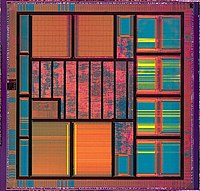
Photo from wikipedia
Electrochemical CO2 reduction to CO is a potential sustainable strategy for alleviating CO2 emission and producing valuable fuels. In the quest to resolve its current problems of low‐energy efficiency and… Click to show full abstract
Electrochemical CO2 reduction to CO is a potential sustainable strategy for alleviating CO2 emission and producing valuable fuels. In the quest to resolve its current problems of low‐energy efficiency and insufficient durability, a dual‐scale design strategy is proposed by implanting a non‐noble active Sn–ZnO heterointerface inside the nanopores of high‐surface‐area carbon nanospheres (Sn–ZnO@HC). The metal d‐bandwidth tuning of Sn and ZnO alters the extent of substrate–molecule orbital mixing, facilitating the breaking of the *COOH intermediate and the yield of CO. Furthermore, the confinement effect of tailored nanopores results in a beneficial pH distribution in the local environment around the Sn–ZnO nanoparticles and protects them against leaching and aggregating. Through integrating electronic and nanopore‐scale control, Sn–ZnO@HC achieves a quite low potential of −0.53 V vs reversible hydrogen electrode (RHE) with 91% Faradaic efficiency for CO and an ultralong stability of 240 h. This work provides proof of concept for the multiscale design of electrocatalysts.
Journal Title: Advanced Materials
Year Published: 2022
Link to full text (if available)
Share on Social Media: Sign Up to like & get
recommendations!